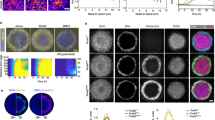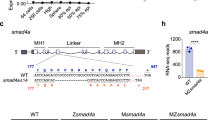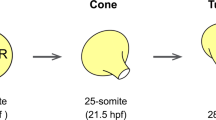Abstract
GROWTH factors related to TGF-β provide important signals for patterning the vertebrate body plan1–3. One such family member, nodal, is required for formation of the primitive streak during mouse gastrulation4–6. Here we have used a nodal–lacZ reporter allele to demonstrate asymmetric nodal expression in the mouse node, a structure thought to be the functional equivalent of the frog and chick 'organizer'7, and in lateral plate mesoderm cells. We have also identified two additional genes acting with nodal in a pathway determining the left–right body axis. Thus we observe in inv mutant embryos8 that the sidedness of nodal expression correlates with the direction of heart looping and embryonic turning. In contrast, HNF3-β+/- nodallacZ/+ double-heterozygous embryos display LacZ staining on both left and right sides, and frequently exhibit defects in body situs. Taken together, these experiments, along with similar findings in chick9, demonstrate that elements of the genetic pathway that establish the left–right body axis are conserved in vertebrates.
This is a preview of subscription content, access via your institution
Access options
Subscribe to this journal
Receive 51 print issues and online access
$199.00 per year
only $3.90 per issue
Buy this article
- Purchase on Springer Link
- Instant access to full article PDF
Prices may be subject to local taxes which are calculated during checkout
Similar content being viewed by others
References
Kessler, D. S. & Melton, D. A. Science 266, 596–604 (1994).
Kingsley, D. M. Genes Dev. 8, 133–146 (1994).
Conlon, F. L. & Beddington, R. S. P. Semin. dev. Biol. 6, 249–256 (1995).
Conlon, F. L., Barth, K. S. & Robertson, E. J. Development 111, 969–981 (1991).
Lannaccone, P. M., Zhou, X., Khokha, M., Boucher, D. & Kuehn, M. R. Devl Dyn. 194, 198–208 (1992).
Conlon, F. L. et al. Development 120, 1919–1928 (1994).
Beddington, R. S. P. Development 120, 613–620 (1994).
Yokoyama, T. at al. Science 260, 679–682 (1993).
Levin, M., Johnson, R. L., Stern, C. D., Kuehn, M. & Tabin, C. Cell 82, 803–814 (1995).
Zhou, X., Sasaki, H., Lowe, L., Hogan, B. L. M. & Kuehn, M. R. Nature 361, 543–547 (1993).
Mountford, P. et al. Proc. natn. Acad. Sci. U.S.A. 91, 4303–4307 (1994).
Cooke, J. Nature 374, 681 (1995).
Beddington, R. S. P. J. Embryol. exp. Morph. 64, 87–104 (1981).
Beddington, R. S. P. J. Embryol. exp. Morph. 69, 265–285 (1982).
Lawson, K. A., Meneses, J. J. & Pedersen, R. A. Development 113, 891–911 (1991).
Tam, P. P. L. & Beddington, R. S. P. Development 99, 109–126 (1987).
Smith, J. L., Gesteland, K. M. & Schoenwolf, G. C. Devl Dyn. 201, 279–289 (1994).
Parameswaran, M. & Tam, P. P. L. Devl. Genet. 17, 16–28 (1995).
Echelard, Y. et el. Cell 75, 1417–1430 (1993).
Chang, D. T. et al. Development 120, 3339–3353 (1994).
Marti, E., Takada, R., Bumcrot, D. A., Sasaki, H. & McMahon, A. P. Development 121, 2537–2547 (1995).
Ang, S.-L. & Rossant, J. Cell 78, 561–574 (1994).
Weinstein, D. C. et al. Cell 78, 575–588 (1994).
Poirier, F. & Robertson, E. J. Development 119, 1229–1236 (1993).
Hogan, B., Beddington, R., Costantini, F. & Lacy, E. Manipulating the Mouse Embryo: A Laboratory Manual. (Cold Spring Harbor Laboratory Press, NY, 1994).
Wilkinson, D. G. in In situ Hybridization (ed. Wilkinson, D. G.) 75–83 (IRL, Oxford, 1992).
Kaufman, M. H. Atlas of Mouse Development (Academic, London, 1992).
Neito, M. A., Bennett, M. F., Sargent, M. G. & Wilkinson, D. G. Development 116, 227–237 (1992).
Smith, D. E., Del Amo, F. F. & Gridley, T. Development 116, 1033–1039 (1992).
Author information
Authors and Affiliations
Rights and permissions
About this article
Cite this article
Collignon, J., Varlet, I. & Robertson, E. Relationship between asymmetric nodal expression and the direction of embryonic turning. Nature 381, 155–158 (1996). https://doi.org/10.1038/381155a0
Received:
Accepted:
Issue Date:
DOI: https://doi.org/10.1038/381155a0
This article is cited by
-
Nodal paralogues underlie distinct mechanisms for visceral left–right asymmetry in reptiles and mammals
Nature Ecology & Evolution (2020)
-
Reply to: Zebrafish prrx1a mutants have normal hearts
Nature (2020)
-
A Requirement for Zic2 in the Regulation of Nodal Expression Underlies the Establishment of Left-Sided Identity
Scientific Reports (2018)
-
The epigenetic modifier Fam208a is required to maintain epiblast cell fitness
Scientific Reports (2017)
-
An Interspecies Heart-to-Heart: Using Xenopus to Uncover the Genetic Basis of Congenital Heart Disease
Current Pathobiology Reports (2017)
Comments
By submitting a comment you agree to abide by our Terms and Community Guidelines. If you find something abusive or that does not comply with our terms or guidelines please flag it as inappropriate.



